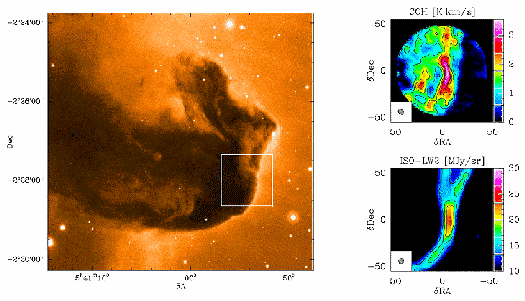Hydrocarbons in the Horsehead mane (21 February 2005)
- Details
- Published on 21 February 2005
Released on February 21st, 2005
''Are PAHs precursors of small hydrocarbons in PDRs? The Horsehead case'', by J. Pety et al.
(Published in Astronomy & Astrophysics. )
This Press Release is issued as a collaboration between Centre National de la Recherche Scientifique and Astronomy & Astrophysics.
In addition to these small hydrocarbons, giant molecules, called polycyclic aromatic hydrocarbons (PAHs), were detected in the early 1980’s, at infrared wavelengths. PAHs are aggregates made of tens to hundreds of mainly carbon and hydrogen atoms. Previous theoretical studies suggested that radiative fragmentation of the PAHs lead to small hydrocarbons. Jérôme Pety (IRAM, France) and his colleagues [1] have now provided one major step toward validating this theoretical hypothesis. They observed the famous Horsehead Nebula with the IRAM Interferometer (Plateau de Bures, France) [2], to search for hydrocarbons and to compare their location with that of PAHs detected a few years ago with the ISO satellite in the same region.
The Horsehead Nebula is one of the most famous and easily-recognizable shapes in the sky. In addition, for astronomers, its light-bathed silhouette is above all a fantastic interstellar chemistry laboratory where high density gas and stellar light interact. More precisely, the Horsehead appears as a dark patch against a bright region (named IC 434). It also undergoes strong ultraviolet radiation that mainly comes from the nearby star σ Orionis. Thanks to the high spatial resolution of the IRAM interferometer, the team was able to explore the edge of the nebula, “the horse mane”, where the gas density increases and the temperature and illumination decrease within a few hundredths of a light-year.
The team discovered three small hydrocarbons (C2H, C3H2, C4H) in the illuminated edge of the nebula. The abundance of these molecules is close to that measured inside interstellar dark clouds. The team was very surprised by the high abundance of C2H, C3H2, C4H in the Horsehead “mane”: these molecules should be destroyed by the intense UV radiation in the edge of the nebula.
Where do the hydrocarbons come from? In their article, Jérôme Pety and his colleagues compare the places where the hydrocarbons have been detected to the places where the ISO satellite detected PAHs. The correspondence between the hydrocarbons’ and the PAHs’ sites is very good and confirms the hypothesis that the hydrocarbons come from the fragmentation of PAHs. Under strong interstellar radiation, PAHs might be eroded and free a large number of small hydrocarbons. This mechanism would be more efficient in regions similar to the edge of the Horsehead Nebula, named “photo-dissociation regions”, in which UV radiation is stronger. This scenario now has to be confirmed by laboratory experiments, such as the experimental set-up PIRENEA in Toulouse (France) [3], for the study of the chemical reactions in the interstellar medium.

[2] For additional information: http://www.iram.fr
[3]For additional information: http://www.cesr.fr/~joblin/PIRENEA/
by J. Pety, D. Teyssier, D. Fosse, M. Gerin, E. Roueff, A. Abergel, E. Habart, J. Cernicharo
Published in Astronomy & Astrophysics (DOI number: 10.1051/0004-6361:20041170)
Contact persons:
- Science:
Dr. Jérôme Pety
Institut de RadioAstronomie Millimétrique
300 rue de la Piscine, Domaine Universitaire
38406 Saint Martin d'Hères, France
Phone: +33 4 76 82 49 87 - Email: This email address is being protected from spambots. You need JavaScript enabled to view it.
- Press office:
Dr. Jennifer Martin
Journal Astronomy & Astrophysics
61, avenue de l'Observatoire
75014 Paris, France
Phone: +33 1 43 29 05 41 - Email: This email address is being protected from spambots. You need JavaScript enabled to view it.
© Astronomy & Astrophysics 2005


